If a pipeline bursts or leaks, it can seriously damage the environment and communities around it. On the other hand, shutting down a pipeline to perform maintenance and repair leads to downtimes that prevent homes and businesses from receiving the power they need. How do companies perform necessary pipeline maintenance without inconveniencing operators or end-users? By executing a line stop and hot tap procedure, pipeline workers can bypass a section of pipe and perform a repair without shutting down the entire system. However, hot tapping isn’t always the right choice. Pipeline owners must carefully weigh the pros and cons of a hot tapping procedure before moving forward. A smart decision about the process means an efficient repair process that minimizes inconvenience for owners, workers, and end-users like you.
Pro: No System Downtime
The biggest benefit of hot tapping is that it eliminates system downtime. Instead of shutting down a pipeline, workers use line stopping and hot tapping equipment to bypass and isolate the section of pipe they need to work on. Product continues to flow through that piece of pipe so that end-user experience no fluctuation in their service. In addition to being more convenient for everyone, this is often a more cost-effective choice for pipeline operators.
Pro: Versatile Materials and Jobs
Pipeline operators can find hot tapping systems to fit nearly any pipe size, material, and type. The right hot tapping equipment can handle the exact pressure and temperature requirements of a pipeline system. Additionally, workers can use hot tapping to repair damaged sections of pipe, retrofit replacement materials, or add new sections of pipe—all while avoiding the need to cut and weld existing pieces of pipe.
Con: Procedure Can Be Difficult
Despite its usefulness, pipeline operators must be careful when executing a hot tapping procedure. During the hot tapping process, workers handle complicated and delicate machinery. They must also deal with the extreme temperature and pressure levels of the running pipeline. Because the pipeline is still in service, mistakes in the procedure pose a greater risk to personnel, equipment, and the surrounding environment.
Con: Requires Extensive Planning
Due to the aforementioned dangers, operators must undergo extensive planning and assessment before deciding to proceed with a hot tapping procedure. A hot work risk assessment and pipeline condition evaluation are just a few of the requirements before executing a line stop and hot tap on a section of pipe. During the planning stage, operators must weigh the pros and cons of a hot tapping procedure to make the best decision for their pipeline. Even after greenlighting the procedure, it takes a lot of work and planning to ensure the process is as safe, efficient, and effective as possible.









 Deering Estate
Deering Estate
 Massage Envy South Miami
Massage Envy South Miami
 Calla Blow Dry
Calla Blow Dry
 My Derma Clinic
My Derma Clinic
 Sushi Maki
Sushi Maki
 Sports Grill
Sports Grill
 The Healthy Kitchen
The Healthy Kitchen
 Golden Rule Seafood
Golden Rule Seafood
 Malanga Cuban Café
Malanga Cuban Café

 Kathleen Ballard
Kathleen Ballard
 Panter, Panter & Sampedro
Panter, Panter & Sampedro
 Vintage Liquors
Vintage Liquors
 The Dog from Ipanema
The Dog from Ipanema
 Rubinstein Family Chiropractic
Rubinstein Family Chiropractic
 Your Pet’s Best
Your Pet’s Best
 Indigo Republic
Indigo Republic




 ATR Luxury Homes
ATR Luxury Homes


 2112 Design Studio
2112 Design Studio
 Hamilton Fox & Company
Hamilton Fox & Company
 Creative Design Services
Creative Design Services
 Best Pest Professionals
Best Pest Professionals
 HD Tree Services
HD Tree Services
 Trinity Air Conditioning Company
Trinity Air Conditioning Company
 Cisca Construction & Development
Cisca Construction & Development
 Mosquito Joe
Mosquito Joe
 Cutler Bay Solar Solutions
Cutler Bay Solar Solutions


 Miami Royal Ballet & Dance
Miami Royal Ballet & Dance
 Christopher Columbus
Christopher Columbus
 Pineview Preschools
Pineview Preschools
 Westminster
Westminster
 Carrollton
Carrollton
 Lil’ Jungle
Lil’ Jungle
 Frost Science Museum
Frost Science Museum
 Palmer Trinity School
Palmer Trinity School
 South Florida Music
South Florida Music
 Pinecrest Orthodontics
Pinecrest Orthodontics
 Dr. Bob Pediatric Dentist
Dr. Bob Pediatric Dentist
 d.pediatrics
d.pediatrics
 South Miami Women’s Health
South Miami Women’s Health

 The Spot Barbershop
The Spot Barbershop
 My Derma Clinic
My Derma Clinic




 Miami Dance Project
Miami Dance Project

 Rubinstein Family Chiropractic
Rubinstein Family Chiropractic
 Indigo Republic
Indigo Republic

 Safes Universe
Safes Universe
 Vintage Liquors
Vintage Liquors
 Evenings Delight
Evenings Delight





 Atchana’s Homegrown Thai
Atchana’s Homegrown Thai
 Baptist Health South Florida
Baptist Health South Florida

 Laser Eye Center of Miami
Laser Eye Center of Miami
 Visiting Angels
Visiting Angels
 OpusCare of South Florida
OpusCare of South Florida

 Your Pet’s Best
Your Pet’s Best





 HD Tree Services
HD Tree Services
 Hamilton Fox & Company
Hamilton Fox & Company


 Creative Design Services
Creative Design Services